This creamy and finger-licking good chocolate peanut butter spread comes together in only 30 minutes, and it's so easy to make.
It's a velvety blend of rich yet simple ingredients and my favorite way of making a delicious sweet and salty homemade chocolate spread.
And the best part? There are no refined sugars or artificial additives—just pure, unadulterated goodness that can also easily fit into a low-carb, vegan, or Paleo-friendly diet.
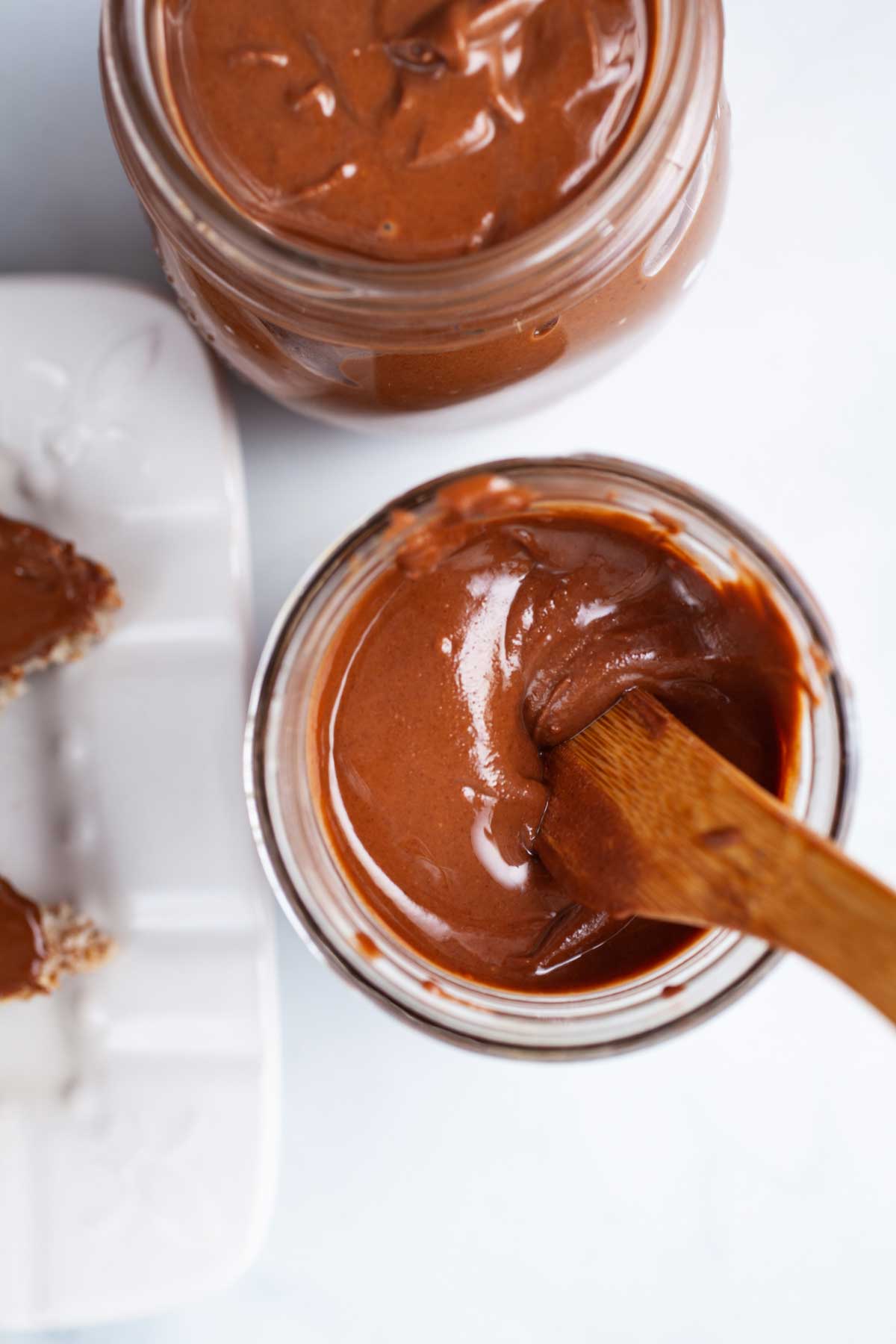
It's no secret that making homemade nut butter is much cheaper and much better than anything store-bought if you've already invested in a food processor or high-powered blender.
You only need one ingredient, (raw) peanuts or other nuts of your choice. And then there are the endless flavors you can add—a tad of salt, cinnamon, sugar-free vanilla extract, and the list goes on.
My family goes through a fair amount of nut butter throughout the week.
This homemade Nutella (or "peanutella") made with creamy peanut butter has a super smooth consistency that makes for an easy spread on toast, waffles, mini doughnuts, fig cake, chia puddings, or drizzle some on these healthy oat flour pancakes!
Let's make it!
Jump to:
Why You'll Love This Chocolate Paste
- A healthy Nutella alternative: It only has roasted unsalted peanuts, cacao or cocoa powder, coconut oil, herbs, and a tad of monk fruit sweetener for the perfect amount of sweetness.
- Adaptable: You can easily replace peanuts with a good mix of nuts of your choice or make a healthy homemade nutella with hazelnuts.
- Super easy to make: You roast the nuts, and then everything goes into a blender.
- Amazing natural flavors: Healthy fats meet natural dark chocolate flavors and a hint of aromatic herbs—it's just so good!
- Long shelf life: It stays smooth and fresh in a dark and cool place for at least a month, or refrigerate for longer storage.
Ingredients
See the recipe card for full information on ingredients and quantities.
Here's what you need to make chocolate peanut butter spread:
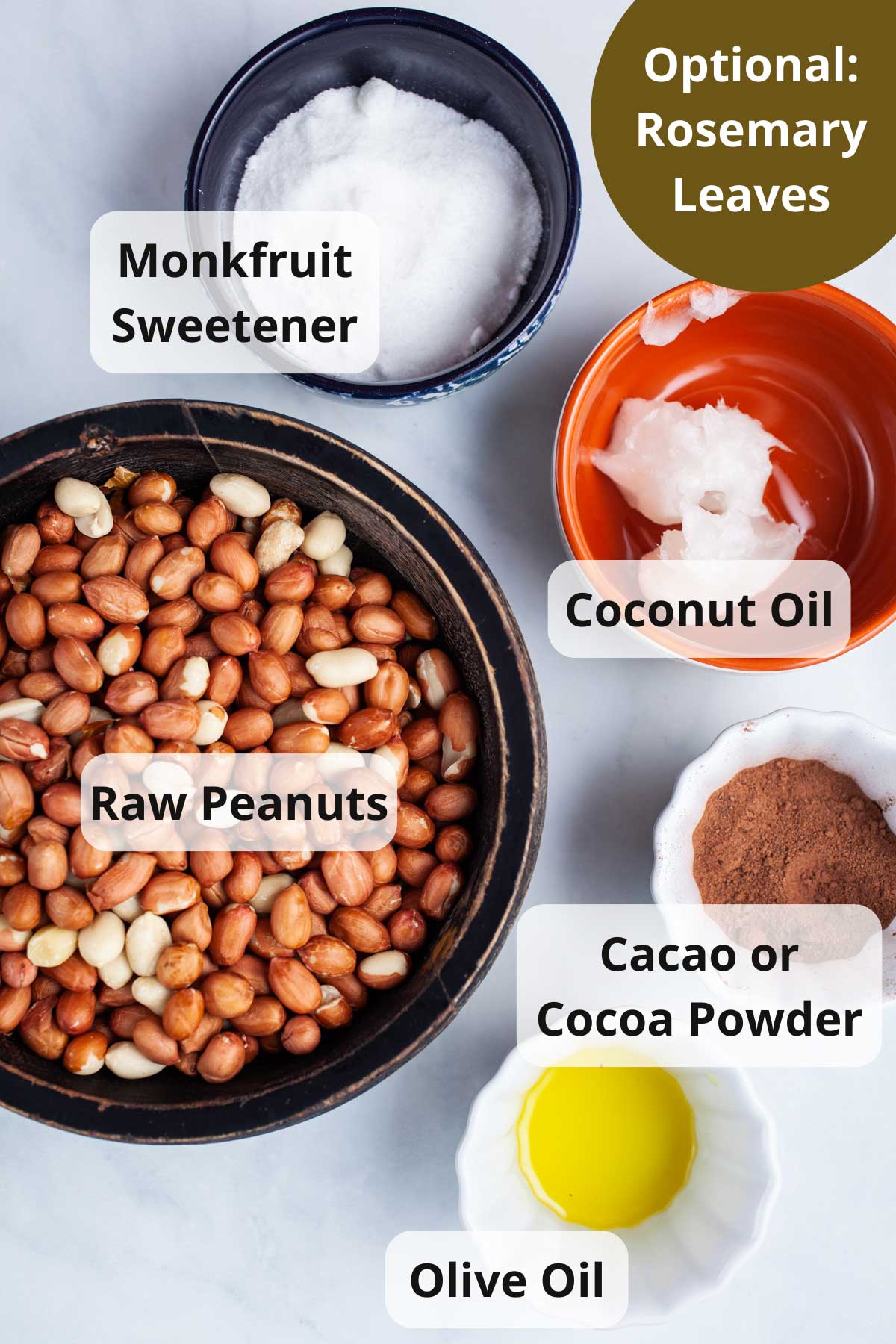
- Peanuts: I usually go for raw, dried, and shelled peanuts and roast them myself. It's so easy to do, and it's hard to beat the flavor of roasted peanuts straight out of the oven.
- Cacao powder: Cocoa powder is a great alternative.
- Coconut oil: This will mix with the natural peanut oil and make the chocolate spread incredibly creamy and glossy.
- Monk fruit sweetener: It adds that perfect hint of sweetness without the need for added sugar.
- A pinch of salt: It balances the other flavors.
- Rosemary leaves and olive oil (optional): This is highly recommended. I usually sprinkle fresh Rosemary with some olive oil to roast next to the peanuts in the oven. Like with one of my rhubarb compote recipes, it adds a sophisticated minty element to the chocolate taste.
How To Make This Chocolate Spread
See the full recipe with measurements in the recipe card.
This "Nutella" chocolate peanut butter spread is rich, with warm undertones, deliciously creamy, a bit festive, and utterly irresistible.
Here is what to do:
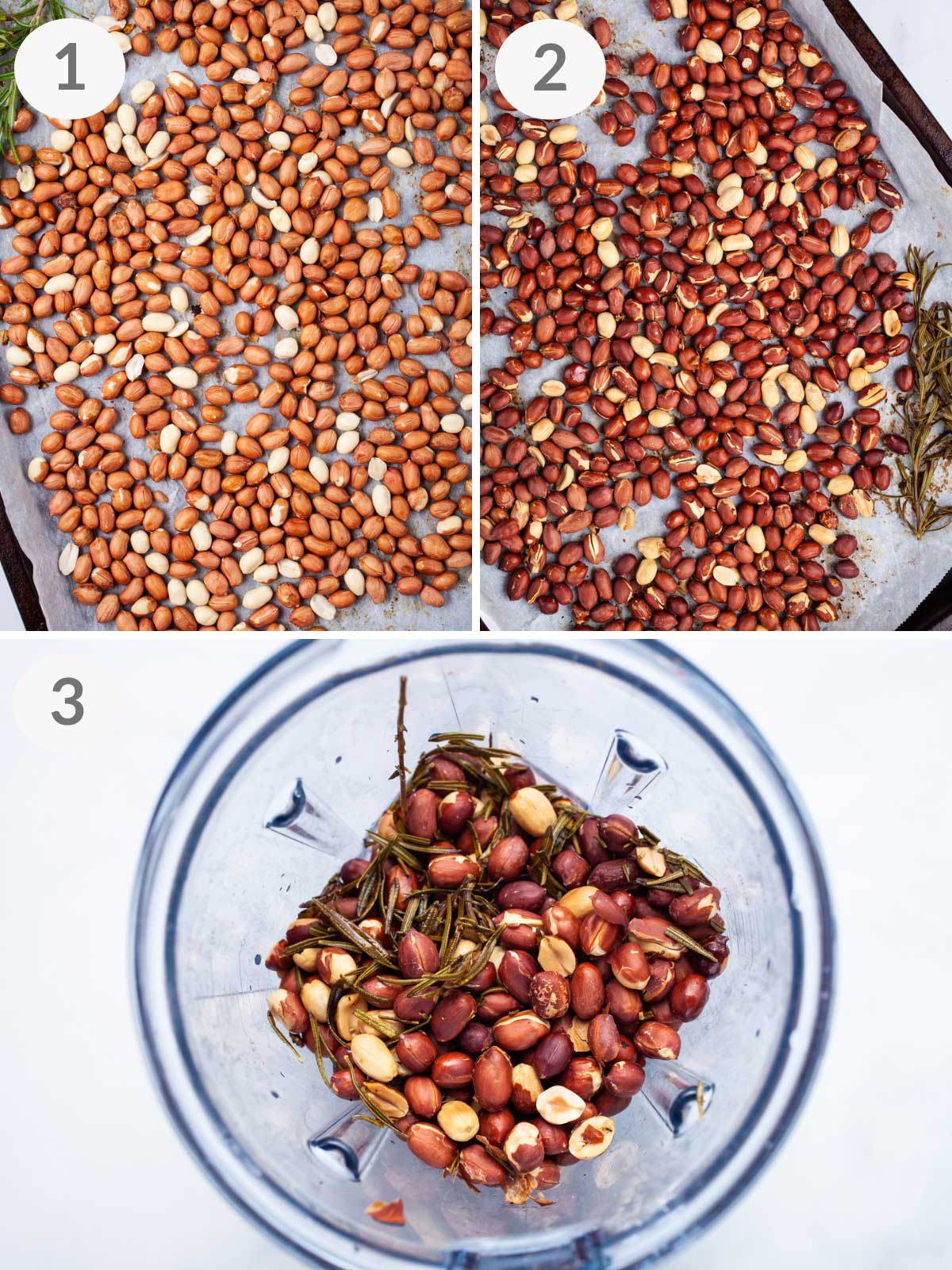
Step One (Picture 1 above) - Spread the shelled and raw peanuts out over a prepared baking sheet in a single layer. Place some olive-coated rosemary next to it (if using).
Step Two (Picture 2 above) - Bake until lightly golden brown. The peanuts will continue to cook when removed from the oven.
Step Three (Picture 3 above) - While still warm (not hot), place the roasted nuts and roasted crushed rosemary leaves in a high-speed blender or food processor.

Step Four (Picture 4 above) - Blend until you have creamy natural peanut butter.
Step Five (Picture 5 above) - Add coconut oil, cacao powder, and monk fruit to the blender.
Step Six (Picture 6 above) - Blend again until you get a beautiful creamy and glossy chocolate peanut butter spread. Immediately spoon the nut butter into a glass jar or container with a lid. Or why wait? Start spreading it on a slice of this amazing almond flour coffee cake.
Helpful Tips
- Raw and shelled nuts: In bulk, they are cheaper than roasted nuts. But you might have to search for them in Asian grocery stores or online.
- Warming the nuts: Even if you use already roasted nuts, I suggest popping them briefly in a preheated 350-degree oven for 8 minutes or until slightly browned and warmed. It will bring out their sweet and nutty flavor, and warmed nuts will help quickly turn them into creamy nut butter.
- Always watch the nuts while in the oven, as burned nuts will have an unpleasant bitter taste.
- There is no need to remove the red skin from shelled roasted peanuts.
- Although optional, roasting and blending rosemary herbs with peanuts adds an incredibly fresh aroma. The needles become brittle after roasting and easily crumble into smaller pieces.
Variations
- You can buy already roasted and unsalted peanuts instead of roasting them yourself. However, it's hard to beat the amazing flavor when the nuts come straight out of the oven.
- Cacao powder: You can substitute this for unsweetened cocoa powder. Add a tad more for an extra dark chocolate peanut butter.
- Sweetener: Adjust this ingredient based on taste by adding more if preferred. I use Monkfruit, a no-carb, no-sugar, no-calorie sweetener (also ideal if you want to make it Keto-Friendly and leaves no aftertaste). If you prefer to work with other low-carb sweeteners such as Stevia, Erythritol, and Swerve, you'll have to adjust the amount to your palate—start with a small amount and work your way up.

Substitutions
- Instead of peanuts, use a mix of nuts of choice: cashews, walnuts, pecans, macadamia, and almonds, to name a few.
- Note: Usually, I make a new batch of nut butter when I have leftovers from many different nuts. It's a great way to clean out your pantry, and I've found that a mixture of nuts used in nut butter adds a lovely complexity. I even throw in some pistachio if I have leftovers from making my pea and pistachio soup.
- Sesame, pumpkin, or sunflower seeds sometimes also end up on the baking sheet and are a great addition to this chocolate spread.
- If you prefer to use agave, liquid honey, or maple syrup to add a touch of sweetness (not a low-carb option), always mix this in after you've made the creamy nut butter and stir it in by hand. Processing any syrup in the blender or food processor with the rest of the ingredients results in sticky nut butter. Also, start with a small amount and work your way up based on taste. Note: it will change the overall taste of the nut butter.
Recipe FAQs
Yes, here are a few tips.
Push the nuts into the blades with your tamper. I usually rotate the tamper and ensure I get all the corners of the container.
You kind of need to butcher the nuts at first, but this ungentle process is what releases their oils and starts making everything creamy.
You'll have creamy nut butter in minutes if you use a Vitamix blender.
Continue to run the blender on high until you have almost a runny consistency. Then add the rest of the ingredients to give it a chocolate flavor.
Yes, here are a few tips.
It might take a little bit longer with a food processor to obtain the same creamy consistency—up to 10 minutes.
And you might need to scrape the sides of the food processor a few times.
You'll see the nuts go through a few stages.
First, it starts with a crumbly consistency, to a ball forming against the sides of the processor (keep scraping the sides from time to time), and then as you keep going, you'll get creamy goodness.
Optional: Add extra virgin coconut oil. It helps increase the level of creaminess, but I hardly ever need to do so.
The jars of nut butter can be stored in a cool and dark place for up to 4 weeks, and it will keep a fairly smooth consistency.
For longer storage, refrigerate in an airtight container.
More Spreads Or Condiments You Might Like
Don't forget to subscribe to my Monthly Newsletter!
Your shares and ratings are valuable to me and so much appreciated. They'll help me create more content you and others can enjoy!
Now go make this chocolate peanut butter spread and immediately slather it on some banana slices for the perfect indulgent snack. Enjoy!
📖 Recipe
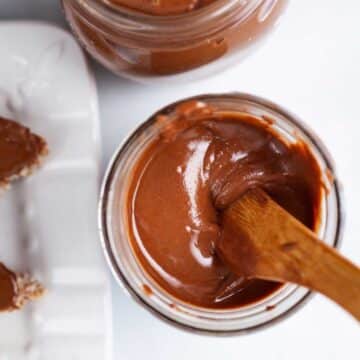
Amazing Homemade Chocolate Peanut Butter Spread
Mariska RamondinoIngredients
- 3 cups raw unsalted and shelled peanuts 440 grams
- 2 sprigs fresh rosemary leaves optional
- 1 teaspoon olive oil optional
- ⅓ cup cacao or cocoa powder 45 grams
- ¼ cup solid coconut oil 56 grams
- ¼ cup Monkfruit sweetener 40 grams plus 2 tablespoons
- 1 pinch of salt
Instructions
- Preheat the oven to 350 degrees F (or 175 °C) and cover the bottom of a large baking sheet with parchment paper.
- Spread the peanuts evenly over the baking sheet in one single layer.3 cups raw unsalted and shelled peanuts
- With a baking brush, coat the rosemary sprigs with olive oil and add them to the side onto the baking sheet.2 sprigs fresh rosemary leaves, 1 teaspoon olive oil
- Transfer the baking sheet to the oven.
- Bake for 15 to 20 minutes or until nuts are slightly browned, and the herbs are dried. Keep an eye on the nuts to ensure that they don't burn. Take them out earlier if needed.
- Remove from the oven and let them sit for a minute.
- Crumble the dried rosemary leaves with your hands into bits and measure out about 1 tablespoon—store any leftovers in a small jar to flavor other dishes.
- While still warm, transfer the nuts and the tablespoon of crumbled rosemary leaves to a high-speed blender or food processor.
- Blend until creamy. With a high-speed blender like a Vitamix, this will only take a few minutes. You must use the tamper tool to push the nuts into the blades. Be a bit more patient with a food processor because it will take a lot longer. It will go from clumps to a bigger ball—keep scraping the sides and blending until very creamy; reserve in the blender or food processor.
- While still hot, add the rest of the ingredients to the blender.⅓ cup cacao or cocoa powder, ¼ cup solid coconut oil, ¼ cup Monkfruit sweetener 40 grams, 1 pinch of salt
- Blend and pulse again until you get a smooth and glossy chocolate spread. The heat will also melt the Monk fruit sweetener.
- Taste test and blend in 2 extra tablespoons of Monk fruit if you prefer a sweeter taste. Note that once cooled, it will taste sweeter.
- Transfer to glass jars or containers with a lid. Be careful because the paste is hot. Allow it to cool with the tops open.
- Store in the pantry or a cool, dark place for about 4 weeks. It will maintain its smooth and spreadable consistency. Refrigerate for longer storage.
Notes
Helpful Tips & Notes
- Raw and shelled nuts: If bought in bulk, they are cheaper than already roasted nuts. I often see large bags in Asian grocery stores, or you can find them online.
- Roasting the nuts: Even if you use already roasted nuts, I suggest popping them briefly in a preheated 350 degrees F oven for 8 minutes or until slightly browned and warmed. Roasting the nuts first brings out their sweet and nutty flavor, and warm nuts will help quickly turn them into creamy butter.
- Always watch the nuts while in the oven, as burned nuts will have an unpleasant bitter taste.
- There is no need to remove the red skin from shelled roasted peanuts.
- Although optional, roasting rosemary herbs with peanuts adds an incredibly fresh aroma. The needles become brittle after roasting and easily crumble into smaller pieces.
Variations & Substitutions
- You can buy already roasted and unsalted peanuts instead of roasting them yourself. However, it's hard to beat the amazing flavor when the nuts come straight out of the oven.
- Instead of peanuts, use a mix of nuts or other nuts of choice: cashews, walnuts, pecans, macadamia, and almonds, to name a few.
- Note: Usually, I make a new batch of nut butter when I have leftovers from many different nuts. It's a great way to clean out your pantry, and I've found that a mixture of nuts used in nut butter adds a lovely, flavorful complexity.
- Sesame, pumpkin, or sunflower seeds sometimes can also end up on the baking sheet and are a great addition to this chocolate spread.
- Cacao powder: you could substitute this for unsweetened cocoa powder. Add a tad more for an extra dark chocolate peanut butter.
- Salt: This is optional, but a little—like a few pinches—is enough to improve the flavors of the nuts and enrich the chocolatey taste.
- Sweetener: adjust by adding more sweetener if preferred. I use Monkfruit, a no-carb, no-sugar, no-calorie sweetener (also ideal if you want to make it Keto-Friendly and leaves no aftertaste). If you prefer to work with other low-carb sweeteners such as Stevia, Erythritol, and Swerve, you'll have to adjust the amount to your palate—start with a small amount and work your way up.
- If you prefer to use agave, liquid honey, or maple syrup to add a touch of sweetness (not a low-carb option), always mix this in after you have made your creamy nut butter and stir it in by hand. Processing any syrup in the blender or food processor with the rest of the ingredients results in sticky nut butter. Also, start with a small amount and work your way up based on taste. Note: It will change the overall taste of the nut butter.
Add your own private notes
Whenever you come back to this recipe, you’ll be able to see your notes.
Nutrition (% Daily value)
Disclaimer: This nutritional data is calculated using third party tools and is only intended as a reference.






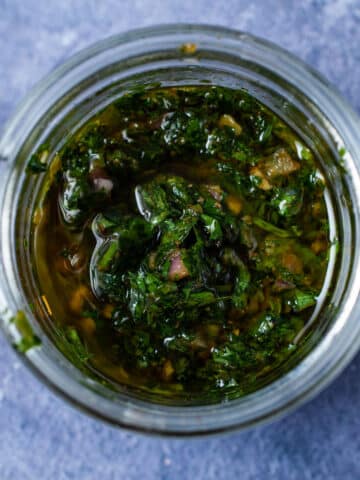
Mariska says
Thank you, dear Reena! I hope you will love it!